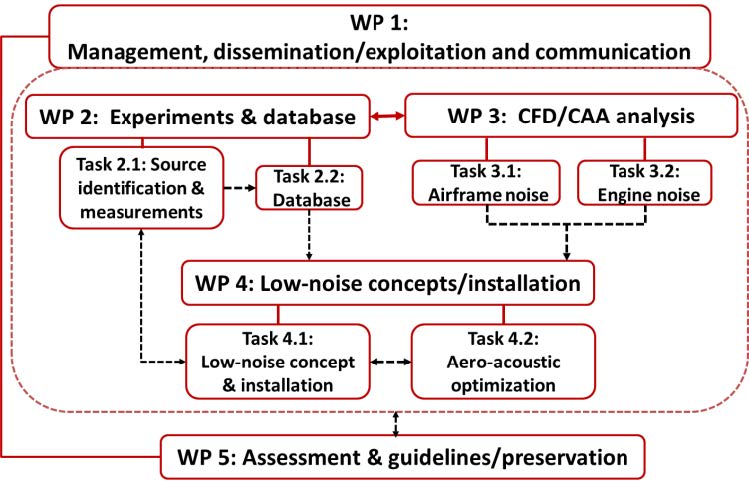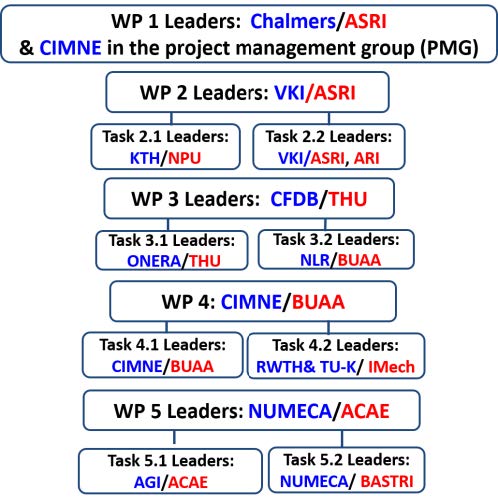Work plan - Work packages, deliverables and milestones
IMAGE consists of 5 work packages, of which WP 1 deals with project management and the other WPs target technical topics. The overall work structure and detailed work plan are given in this section. Figure 3.1 provides an overall view of the work structure in terms of WPs and their interaction.


Figure 3.1: Work package structure and interaction (left) and WP/task leaders (right). For information, the corresponding WP leaders and task leaders on the Chinese side are also given on the right-hand-side chart.
Overall Work Structure
The IMAGE project is carried out in an EU-China collaborative framework of two projects (the Chinese part and EU part) closely linked via a Coordination Agreement to ensure the synergies under a single framework. The description of actions of the EU part sets out the research carried out by European beneficiaries under the EU-funded project. A description of contributions from the participants of China to respective tasks are also provided (including the PMs) for information and also to emphasize that IMAGE is a collaborative project in a single framework in which the research actions are coordinated, although legally separate. The description of Chinese participants will be provided further as an appendix in conjunction with the Coordination Agreement.
The IMAGE project is to carry out upstream research in order to understand the key features of noise generation mechanisms and to explore in details the potential of some of the currently most promising and representative control technologies. The project targets the following five specific technical issues: flow-induced noise generation; aerodynamic and aero-acoustic measurements and related experimental technologies; Noise-source control strategies; Noise propagation and acoustic liners; Low-noise optimization and installation effects. Thereto, a well balanced mix of experimental and numerical activities is planned.
The project coordination and management is conducted in Task 1.1 of WP 1. Within WP 1, Task 1.2 concerns the setup of project website and Task 1.3 the dissemination and exploitation of project results.
The very specific investigations in IMAGE will require tailoring of the simulation and testing procedures. The upgrade of innovative experimental techniques and measurements is dealt with in WP 2. Sophisticated techniques for the identification of noise source, as well as noise generation and propagation will be addressed in Task 2.1. Inverse beamforming techniques will be upgraded to better address the particular problem of airframe flow-induced noise. Moreover, experimental technologies will be advanced for duct noise propagation with wall acoustic impedance. In Task 2.2, experiments will be conducted to characterise the noise control techniques. This will be employed to develop and calibrate numerical models of these technologies in WP3. The basic airframe and engine configurations are then measured using the upgraded experimental methods to generate a detailed database of the physical mechanisms involved in the flow and acoustic control.
Numerical modelling of noise control technologies (turbulence screens, plasma actuators and acoustic liners) in up-to-date CFD/CAA methodologies will be carried out in WP 3. As a first step, the simulation techniques for flow-induced noise will be benchmarked against the fundamental baseline (i.e. no control) configurations (tandem cylinders, wing mock-up, engine duct and/or jets) measured in WP 2. In a second step, numerical models of the noise control technologies will be developed and calibrated. Some effort will also be dedicated to improved methods for noise source modelling. These models will then be implemented in the CFD/CAA chains and applied in new simulations of the same fundamental configurations with active noise reduction devices and validated against measurements from WP 2. In Task 3.1, the efforts will be dedicated to the airframe noise generation, propagation and control whereas Task 3.2 deals with engine noise and its control.
In WP 4 low-noise concepts will be investigated including installation effects, and aero-acoustic optimization will be conducted for an airframe noise configuration with control strategies explored in WP 2 and WP 3. The low-noise configurations and installation effects are studied in Task 4.1 and the acoustic optimization focusing on controlled airfoil or high-lift configurations in Task 4.2. In the latter, the parameters of the control strategy will be optimized to achieve the maximum possible noise reduction for the studied concept.
Finally, Task 5.1 in WP 5 will deal with an overall technical assessment of the applicability of the control strategies (studied in WPs 2 and 3) for realistic configurations, as well as to the low-noise (optimized) concepts/configurations (WP 4). This task is complemented by Task 5.2, which draws best practice guidelines from the conclusions and lessons learned in the project. Another important part in Task 5.2 concerns the knowledge preservation. In this task a database of the test cases, results and knowledge generated from WPs 2-5 will be established for common access for the IMAGE partners and also for other Chinese and European researchers engaged in related future research work.


